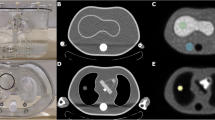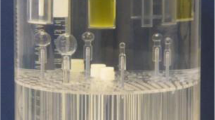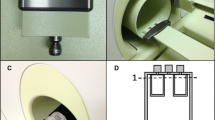Abstract
Purpose
Non-invasive in vivo positron emission tomography (PET) provides high detection sensitivity in the nano- to picomolar range and in addition to other advantages, the possibility to absolutely quantify the acquired data. The present study focuses on the comparison of transmission data acquired with an X-ray computed tomography (CT) scanner or a Co-57 source for the Inveon small animal PET scanner (Siemens Healthcare, Knoxville, TN, USA), as well as determines their influences on the quantification accuracy and partial volume effect (PVE). A special focus included the impact of the performed calibration on the quantification accuracy.
Procedures
Phantom measurements were carried out to determine the quantification accuracy, the influence of the object size on the quantification, and the PVE for different sphere sizes, along the field of view and for different contrast ratios.
Results
An influence of the emission activity on the Co-57 transmission measurements was discovered (deviations up to 24.06 % measured to true activity), whereas no influence of the emission activity on the CT attenuation correction was identified (deviations <3 % for measured to true activity). The quantification accuracy was substantially influenced by the applied calibration factor and by the object size. The PVE demonstrated a dependency on the sphere size, the position within the field of view, the reconstruction and correction algorithms and the count statistics. Depending on the reconstruction algorithm, only ∼30–40 % of the true activity within a small sphere could be resolved. The iterative 3D reconstruction algorithms uncovered substantially increased recovery values compared to the analytical and 2D iterative reconstruction algorithms (up to 70.46 % and 80.82 % recovery for the smallest and largest sphere using iterative 3D reconstruction algorithms). The transmission measurement (CT or Co-57 source) to correct for attenuation did not severely influence the PVE.
Conclusions
The analysis of the quantification accuracy and the PVE revealed an influence of the object size, the reconstruction algorithm and the applied corrections. Particularly, the influence of the emission activity during the transmission measurement performed with a Co-57 source must be considered. To receive comparable results, also among different scanner configurations, standardization of the acquisition (imaging parameters, as well as applied reconstruction and correction protocols) is necessary.






Similar content being viewed by others
References
Boellaard R (2009) Standards for PET image acquisition and quantitative data analysis. J Nucl Med 50(Suppl 1):11S–20S
Cherry SR (2004) In vivo molecular and genomic imaging: new challenges for imaging physics. Phys Med Biol 49:R13–R48
National Electrical Manufacturers Association (2008) NEMA Standard Publication NU 4–2008: Performance Measurements of Small Animal Positron Emission Tomographs. Rosslyn, VA: National Electrical Manufacturers Association
Mannheim JG, Judenhofer MS, Schmid A et al (2012) Quantification accuracy and partial volume effect in dependence of the attenuation correction of a state-of-the-art small animal PET scanner. Phys Med Biol 57:3981–3993
Disselhorst JA, Brom M, Laverman P et al (2010) Image-quality assessment for several positron emitters using the NEMA NU 4-2008 standards in the Siemens Inveon small-animal PET scanner. J Nucl Med 51:610–617
Cheng JC, Shoghi K, Laforest R (2012) Quantitative accuracy of MAP reconstruction for dynamic PET imaging in small animals. Med Phys 39:1029–1041
van Velden FH, Kloet RW, van Berckel BN et al (2008) Impact of attenuation correction strategies on the quantification of high resolution research tomograph PET studies. Phys Med Biol 53:99–118
Soret M, Bacharach SL, Buvat I (2007) Partial-volume effect in PET tumor imaging. J Nucl Med 48:932–945
Lehnert W, Gregoire MC, Reilhac A, Meikle SR (2012) Characterisation of partial volume effect and region-based correction in small animal positron emission tomography (PET) of the rat brain. NeuroImage 60:2144–2157
Bailey DL, Karp JS, Surti S (2005) Physics and instrumentation in PET. In: Bailey DL, Townsend DW, Valk PE, Maisey MN (eds) Positron emission tomography: basic sciences. Springer London, London, pp 13–39
Lecomte R (2009) Novel detector technology for clinical PET. Eur J Nucl Med Mol Imaging 36(Suppl 1):S69–S85
Author information
Authors and Affiliations
Corresponding author
Ethics declarations
Disclosure
This work was part of the PhD thesis of Julia G. Mannheim.
Conflict of Interest
The authors declare that they have no conflict of interest.
Electronic Supplementary Material
ESM 1
(DOC 317 kb)
Rights and permissions
About this article
Cite this article
Mannheim, J.G., Schmid, A.M. & Pichler, B.J. Influence of Co-57 and CT Transmission Measurements on the Quantification Accuracy and Partial Volume Effect of a Small Animal PET Scanner. Mol Imaging Biol 19, 825–836 (2017). https://doi.org/10.1007/s11307-017-1074-x
Published:
Issue Date:
DOI: https://doi.org/10.1007/s11307-017-1074-x




